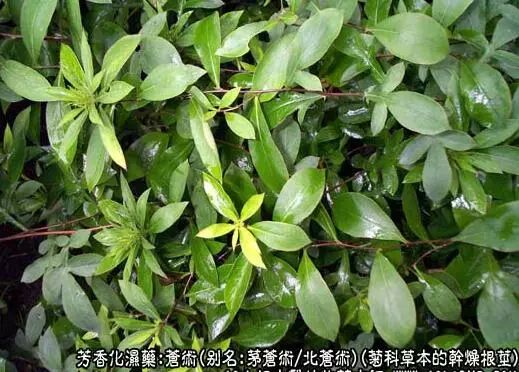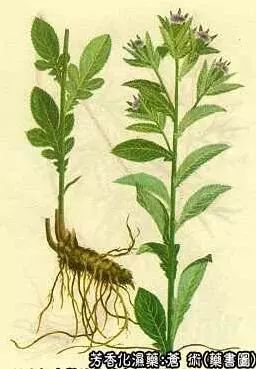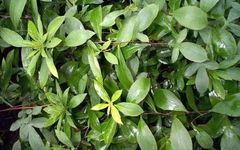To prevent not finding it next time


Atractylodes is a commonly used traditional Chinese medicine. It is classified as a superior herb in the “Shennong Bencao Jing” (Shennong’s Classic of Materia Medica). Originally named “Zhu” (术), it was later differentiated into Bai Zhu (白术, White Atractylodes) and Cang Zhu (苍术, Atractylodes lancea) by Tao Hongjing in the “Ming Yi Bie Lu”. Currently, Cang Zhu is further divided into two categories: one produced in East China and South China, which, when sliced, shows white mold resembling hair, known as Mao Cang Zhu (毛苍术); the other produced in Northeast China and East China, which does not develop white mold when sliced, is called Shan Cang Zhu (山苍术).
Aliases: Mao Cang Zhu (毛苍术, Hairy Atractylodes), Bei Cang Zhu (北苍术, Northern Atractylodes).
Source: Dried rhizomes of perennial herbaceous plants in the Asteraceae family: Mao Cang Zhu (Atractylodes lancea (Thunb.) DC.), Guan Cang Zhu (关苍术), and Bei Cang Zhu (Atractylodes chinensis (DC.) Koidz.). All are wild-harvested.
Harvesting and Storage: Harvest the rhizomes 2-3 years after cultivation, from early September to early November or in February to March of the following year. Remove residual stems, shake off the soil, dry in the sun, and remove the roots or scorch them with fire after drying to about 90% moisture, then dry completely.
Production Areas: Mao Cang Zhu is mainly produced in the Maoshan area of Jiangsu Province (hence the name Mao Cang Zhu), as well as in Xiangfan, Hubei Province, Xinyang, and Nanyang in Henan Province. It is also produced in Anhui, Zhejiang, Jiangxi, and other provinces. Shan Cang Zhu is primarily produced in North China and Northeast provinces, with production also in Shandong, Shaanxi, and Gansu.
Identification:
(1) Mao Cang Zhu: The rhizome is irregularly nodular or slightly cylindrical, sometimes curved, usually branched, 3-10 cm long and 1-2 cm in diameter. The surface is yellow-brown to gray-brown, with fine longitudinal wrinkles and a few residual root hairs. The nodes often have shallow transverse grooves, and the internodes have round stem scars, often with residual stem bases at one end. Occasionally, white crystalline substances may appear on the surface. The texture is solid, easily broken, with a slightly uneven fracture surface, which is whitish or yellowish-white, scattered with numerous orange-yellow or reddish-brown oil chambers (commonly known as vermilion dots). When exposed for a while, white needle-like crystals may appear. The transverse section does not show blue fluorescence under ultraviolet light (254 nm). It has a strong aroma and a slightly sweet, bitter, and spicy taste.
(2) Bei Cang Zhu: The rhizome is often in a lump-like form, sometimes cylindrical and nodular, usually curved with short branches, 4-10 cm long and 0.7-4 cm in diameter. The surface is black-brown, with oil chambers on the outside, and does not produce crystals upon standing. The aroma is weaker, with a bitter and spicy taste.
(3) Guan Cang Zhu: The rhizome is mostly cylindrical and nodular, 4-12 cm long and 1-2.5 cm in diameter, with a deep brown surface. The texture is lighter, with a fibrous fracture surface. It has a unique aroma and a spicy, slightly bitter taste.
The best quality is characterized by a solid texture, numerous vermilion dots on the fracture surface, and a strong aroma.
Main Components: Contains volatile oils, primarily Atractylon (C15H26O) and Atractylone (C15H20O). Also contains a large amount of vitamin A and vitamin D (but the water decoction does not contain vitamin A) (Note: Chemical element numbers are reduced and placed in the lower right).
Preparation:
1. Cang Zhu: Remove impurities, soak in water until 70-80% translucent, take out, and slice after moistening, then dry in the sun.
2. Fried Cang Zhu: Take Cang Zhu slices, spray with rice wash water to moisten, and stir-fry in a pot over low heat until slightly yellow; or take cleaned Cang Zhu, soak in rice wash water, then steam until thoroughly cooked, slice, and dry.
3. Charred: Take Cang Zhu slices, stir-fry over high heat until the surface is charred black, with the inside remaining yellow, then remove and dry.
4. Salted: Take Cang Zhu, stir-fry over high heat until the outer skin is charred black, add salt water, and stir-fry until dry. For every pound of Cang Zhu, add 5 qian of salt and an appropriate amount of water.
5. Cang Zhu is dry in nature, so it is soaked in glutinous rice wash to remove its oil, sliced, and dried. It can also be stir-fried with sesame oil to reduce its dryness.
Properties: Spicy, bitter, and warm.
Meridians Entered: Spleen and Stomach.
Functions: Dries dampness, strengthens the spleen, dispels wind, scatters cold, and brightens the eyes.
Indications: Spleen dampness causing dysfunction in transportation, loss of appetite, nausea, abdominal distension, diarrhea; joint and limb pain.
Pharmacological Effects:
1. Anti-hypoxia: In a mouse hypoxia model induced by potassium cyanide, the acetone extract of Cang Zhu at 750 mg/kg significantly increased the survival time of mice and reduced the relative mortality rate. The main active component of Cang Zhu against hypoxia is β-eucalyptol.
2. Effects on the digestive tract: The volatile oils in Cang Zhu have carminative and stomach-strengthening effects, and the bitterness also promotes appetite. Experiments have shown that Cang Zhu significantly alleviates intestinal spasms induced by the parasympathetic neurotransmitter acetylcholine. In normal rabbits, Cang Zhu reduces the tension of the small intestine. It also relaxes the intestinal muscles in rabbits induced by the sympathetic neurotransmitter epinephrine, and Cang Zhu preparations can restore the amplitude suppressed by epinephrine. Additionally, Cang Zhu can counteract hydrochloric acid-induced acute gastritis and pyloric ligation-induced gastric ulcers in rats through its anticholinergic effects; furthermore, Atractylon promotes gastrointestinal motility and has a slight contraction effect on gastric smooth muscle.
3. Cardiovascular effects: Cang Zhu has a mild inhibitory effect on the heart of toads and a slight dilating effect on the blood vessels of toads’ hind limbs. Low-dose intravenous injection of Cang Zhu extract can mildly increase blood pressure in rabbits, while high doses can decrease blood pressure.
4. Central nervous system inhibition: The volatile oil of Cang Zhu has a sedative effect on frogs in small amounts, while larger amounts exhibit inhibitory effects, leading to respiratory paralysis and death. The inhibitory components are mainly β-eucalyptol and Mao Cang Zhu alcohol. Mao Cang Zhu and its β-eucalyptol also have an anti-convulsant effect against electric shock-induced spasms in mice.
5. Effects on the liver: A water decoction of Cang Zhu at 10 g of crude drug/kg administered to mice for 7 days significantly promotes liver protein synthesis. The crude drug and its components, Atractylon, Atractylone, and β-eucalyptol, have significant protective effects against carbon tetrachloride-induced damage in primary cultured mouse liver cells.
6. Effects on blood sugar: Oral or subcutaneous injection of Cang Zhu decoction or alcohol extract at 8 g/kg causes a slight increase in blood sugar in normal rabbits. A decoction at 10 g/kg also produces the same effect; however, in alloxan-induced diabetic rabbits, blood sugar initially rises but then decreases within 10 days of administration, with no return to pre-treatment levels after stopping the drug for 7-14 days. Atractylon has a hypoglycemic effect in mice, rats, and rabbits, reducing muscle and liver glycogen, inhibiting glycogenesis, decreasing oxygen consumption, and increasing blood lactate levels. Its hypoglycemic effect may be related to its inhibition of the Pasteur effect in the body. It competes with adenosine monophosphate at the same mitochondrial receptor site, thereby inhibiting oxidative phosphorylation and interfering with energy transfer processes.
7. Effects on the urinary system: Rat experiments have shown that Mao Cang Zhu decoction does not have a diuretic effect but significantly increases the excretion of sodium and potassium.
8. Antibacterial and disinfectant effects: Prepared Cang Zhu is placed in a covered enamel container, soaked in 95% alcohol until submerged, for 8-10 hours. After removing the Cang Zhu, it is placed on the floor of a sterilized operating room and ignited until it turns to ash. The results show a significant reduction in bacterial counts after disinfection compared to before, indicating satisfactory disinfection effects.
Clinical Applications: An important herb for dispelling dampness, applicable for both internal and external dampness. Previous experience states: “Cang Zhu is most effective for treating external dampness.”
1. Used to treat indigestion (commonly referred to as dampness obstructing the middle burner), characterized by fullness and discomfort in the stomach, loss of appetite, or vomiting and diarrhea, often combined with Hou Po (厚朴, Magnolia Bark) and Chen Pi (陈皮, Aged Tangerine Peel) in formulas like Ping Wei San (平胃散); if there is a tendency towards heat stagnation, it can also be combined with Xiang Fu (香附, Cyperus) and Shen Qu (神曲, Fermented Barley) or Zhi Zi (栀子, Gardenia).
2. Used to treat diarrhea, especially summer watery diarrhea with significant damp-heat, often combined with Yin Hua (银花, Honeysuckle) and Fu Ling (茯苓, Poria).
3. Used to treat rheumatism, especially muscular rheumatism. Commonly combined with Ma Huang (麻黄, Ephedra), Gui Zhi (桂枝, Cinnamon Twig), and Yi Yi Ren (苡仁, Job’s Tears) to enhance analgesic effects. If there is heat bi with fever, thirst, red and swollen joints, yellow tongue coating, and rapid pulse, it can be combined with Shi Gao (石膏, Gypsum) to clear heat, as in Bai Hu Jia Cang Zhu Tang (白虎加苍术汤) with modifications.
4. Used in surgery, it has certain effects on treating jaundice and perianal tuberculosis. It can also treat lower limb abdominal distension and pain due to damp-heat resembling erysipelas, often combined with Huang Bai (黄柏, Phellodendron) and Niu Xi (牛膝, Achyranthes) in formulas like Si Miao Wan (四妙丸).
5. Used in ophthalmology to treat night blindness and corneal softening after measles, utilizing its vitamin A content, often taken in pill or powder form (there are reports of effectiveness with decoction as well). It can be used alone in powdered form or combined with Mu Zei (木贼, Equisetum). Prescription: Cang Zhu 120 g, Mu Zei 60 g, ground into powder and mixed; take 3-6 g with meals or combined with lamb liver.
Additionally, it can be used for strengthening the body. It treats mental fatigue, limb weakness, especially in cases of deficiency and cold, often combined with Shu Di Huang (熟地, Rehmannia) and Gan Jiang (干姜, Dried Ginger).
Precautions: Cang Zhu is relatively spicy and dry, so it is not suitable for those with yin deficiency and blood dryness, or those with hemoptysis and epistaxis.
Note: Both Cang Zhu and Hou Po can transform dampness. When treating fullness and vomiting in the gastrointestinal tract, they are often used together, but Cang Zhu is more effective in dispelling wind and drying dampness; for warming the middle and relieving fullness, Cang Zhu is less effective than Hou Po.
Dosage: Internal use: decoction, 3-9 g; or in pills or powders.
Storage: Store in a cool, dry place.
Formulas:
1. Ping Wei San (平胃散) for treating disharmony of the spleen and stomach, loss of appetite, fullness and stabbing pain in the heart and abdomen, bitter mouth, nausea, and frequent diarrhea: Cang Zhu (去粗皮,米泔浸二日) 5 jin, Hou Po (去粗皮,姜汁制,炒香), Chen Pi (去白) each 3 jin 2 liang, Gan Cao (炒) 30 liang. Grind into fine powder. Each dose is 2 qian, boiled with 1 cup of water, adding 2 slices of fresh ginger and 2 jujubes, simmer until reduced to 70%, remove ginger and jujubes, and take warm before meals; adding a pinch of salt and boiling soup is also acceptable. (From “Jufang” Ping Wei San)
2. Bai Hu Jia Cang Zhu Tang (白虎加苍木汤加减): Cang Zhu 9 g, Sheng Shi Gao (生石膏, Raw Gypsum) 30 g (crushed and boiled first), Zhi Mu (知母) 12 g, Gan Cao 6 g, Sang Zhi (桑枝, Mulberry Twig) 12 g, Fang Ji (防己, Stephania) 9 g, Yin Hua Teng (银花藤, Honeysuckle Vine) 9 g, boiled in water.
3. Si Miao Wan (四妙丸): Cang Zhu, Huang Bai, Niu Xi, and Sheng Yi Ren each in equal parts, ground into powder, made into pills, each dose 6-9 g, taken with hot water.
If you find this useful, Remember to follow!
Remember to follow!
Editor shares good articles with friends
1.6 inexpensive and effective medicines from pharmacies that staff generally won’t recommend, worth noting
2. Pharmacopoeia: 3 types of Chinese herbs have been banned! They have nephrotoxicity and carcinogenic properties, don’t think they are good medicines
3.Life Encyclopedia: Is there a sale of dissolving oil in pharmacies?
4.Life Encyclopedia: Why is Noteland so cheap on Douyin?
Like is a form of encouragement Share to spread joy
After reading, please click“Looking”

